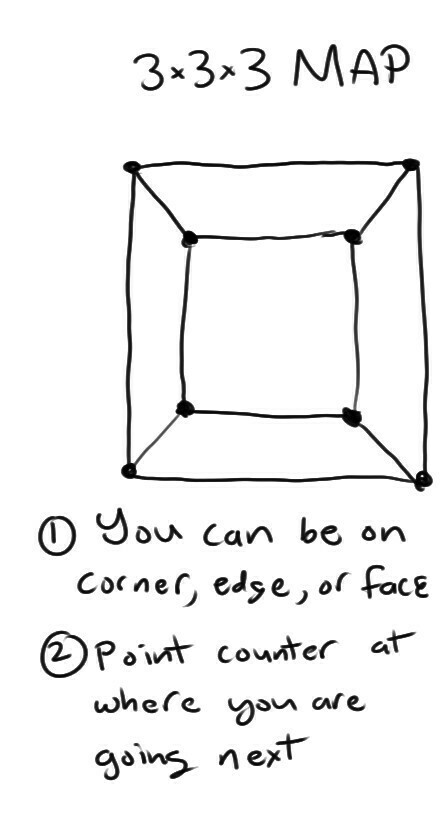3x3x3Space
An orbital space combat game in 3 dimensions
I've come up with an elegant board game design for 3 dimensional orbital space combat. The emphasis is on simulating the decisions, rather than fine details of orbital motion.
There are three distinct scales of motion:
1) Orbital Level - 3x3x3 sector map
2) Approach Level - no map, just a delta-v auction to determine Z gap of closest approach
3) Tactical Level - flat X-Y map, but with a fixed Z gap between the opposing task forces
Orbital Level
Sectors are defined by a 3x3x3 Rubik's Cube, with the planet/moon in the center. You can occupy any of the 26 corners, edges, or faces. An orbit consists of 8 sectors, either parallel to a face or aligned with opposite edges.
The map is a flat image of a cube, with 8 dots for the corners and 12 edges connecting them. You place a task force counter on a corner, edge, or face, pointed at where you are headed next.
This system elegantly enforces movement along the 9 allowed orbits. When you're on a face, you can point to 8 possible neighbors. When you're on a corner, you can point to 6 possible neighbors. When you're on an edge, you can only point to 4 possible neighbors. In particular, this does NOT allow going from one edge to another, which would result in 4 more possible orbits. These pure edge orbits are only 6 sectors around (rather than 8) and they're more difficult to visualize.
Normal orbital movement is determine by your "orbital period". There is a hard lower limit on your orbital period - below that, you would crash into the planet/moon. You can spend delta-v to increase or lower your period. You can also spend delta-v to perform a plane change, but this costs a lot of delta-v. Thus, it's more typical to adjust period to try and intercept or avoid the enemy.
You can also perform an aeromaneuver once per orbit. All ships can perform a mild aerobrake, that lowers your orbital period a small amount. A heat shield allows a heavy aerobrake, that lowers your orbital period a large amount. Lifting body spacecraft can also perform an aeromaneuver that does a plane change, at some cost to your orbital period.
This movement system feels a bit like air combat, where "speed is life". In air combat maneuvering, everything costs you energy in the form of speed and/or altitude. In orbital maneuvering, orbital energy has a similar role - at least when there's an atmosphere to work with.
Approach Level
When a taskforce enters a sector occupied by enemies, either side may choose to attempt an intercept. The base delta-v cost and starting Z is determined randomly, before the decision.
If one side is willing to pay the base delta-v cost, it begins the detla-v auction at T-10. Time counts down from T-10 to T-1. Both players may choose to add or remove Z, according to delta-v. This delta-v is multiplied by the time remaining to determine its effect on Z. Clip Z at zero rather than going negative.
Tactical Level
At T-0, the scale switches to the tactical map, which looks like a narrow corridor. The opposing forces coast in opposite directions, separated by the Z gap. During this time, no maneuvering is allowed. This isn't 100% realistic, but I deem it adequate. The idea is to streamline tactical combat resolution, rather than burden the players with too many minor decisions.
As the opposing forces pass each other, they may roll/pitch/yaw in 90 degree increments.
#3x3x3Space #Tabletop

